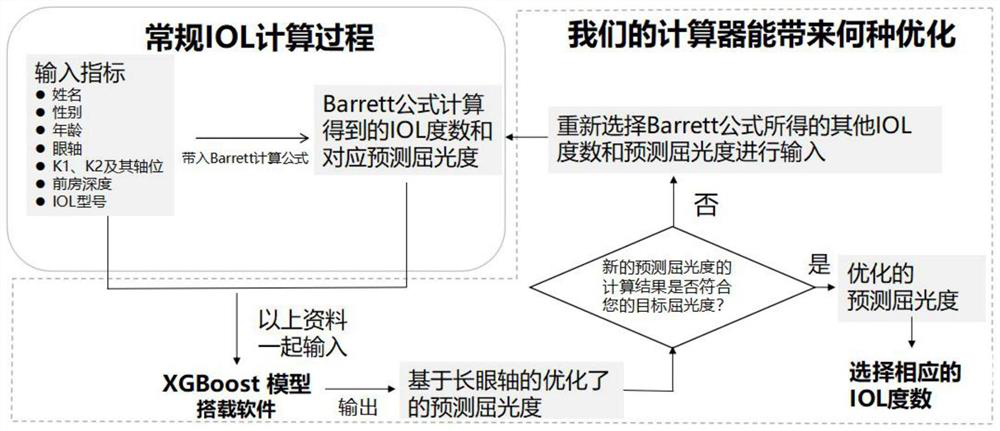Artificial intelligence assisted optimized highly myopia intraocular lens degree calculator
An intraocular lens and artificial intelligence technology, applied in the medical field, can solve problems such as inaccurate calculations, prediction errors, and large errors, and achieve the effects of increasing visual effects, ease of use, and increasing satisfaction
- Summary
- Abstract
- Description
- Claims
- Application Information
AI Technical Summary
Problems solved by technology
Method used
Image
Examples
Embodiment 1
[0036]Among the latest generation of intraocular lens calculation formulas, the Barrett Universal II formula is recognized as the most accurate calculation formula. Therefore, based on the Barrett Universal II formula, we calculate the intraocular lens diopter and predict the diopter after operation, as well as high myopia cataract Multiple biometric parameters of 1450 eyes in the database, machine learning using artificial intelligence XGBoost algorithm. The included learning features include: age, eye axis, anterior chamber depth, corneal steep axis curvature and axial position, corneal flat axis curvature and axial position, intraocular lens implantation power and A constant, and the prediction of Barrett Universal II formula back calculation Diopters. The learning goal is the real diopter of the patient more than one month after surgery. The model building process is divided into data cleaning, preprocessing, consideration of whether each learning feature is included in t...
Embodiment 2
[0040] A 55-year-old female patient with right eye high myopia complicated with cataract, right eye axis 31.31mm, anterior chamber depth 3.78mm, corneal flat axis curvature 43.51D, axial position 10°, corneal steep axis curvature 45.01D, axial position 100°, proposed Implanted intraocular lens MCX 11ASP, A constant 119.4, planned to reserve -2.50D after operation, substituted into Barrett Universal II formula, obtained +4.0D predicted diopter of intraocular lens was -2.94D, and substituted into the artificial intelligence assisted optimization height of the present invention Myopia intraocular lens diopter calculator, obtained the predicted diopter of +4.0D intraocular lens to be -2.56D, then implanted +4D intraocular lens after intraoperative cataract suction, and subjective optometry one month after operation to get the actual postoperative The diopter is -2.50D. Patients have good vision, quick recovery and high satisfaction. This calculator is more accurate in predicting ...
Embodiment 3
[0042] A 56-year-old male patient with left eye high myopia complicated with cataract, left eye axis 27.87mm, anterior chamber depth 3.42mm, corneal flat axis curvature 41.93D, axial position 3°, corneal steep axis curvature 43.32D, axial position 93°, proposed Implanted intraocular lens Rayner 920H A, A constant 118.6, reserved -3.5D after the planned operation, substituted into Barrett Universal II formula, obtained +14.0D predicted diopter of intraocular lens is -3.11D, and substituted into the artificial intelligence assisted optimization of the present invention The intraocular lens diopter calculator for highly myopic eyes obtained the predicted diopter of +14.0D intraocular lens as -3.65D, so a +14.0D intraocular lens was implanted after intraoperative cataract extraction, and the actual optometry was obtained one month after the operation. The postoperative diopter was -4.25D. The prediction error of this calculator for the postoperative reserved diopter of high myopia...
PUM
| Property | Measurement | Unit |
|---|---|---|
| Depth | aaaaa | aaaaa |
| Diopter | aaaaa | aaaaa |
| Diopter | aaaaa | aaaaa |
Abstract
Description
Claims
Application Information
 Login to View More
Login to View More - R&D
- Intellectual Property
- Life Sciences
- Materials
- Tech Scout
- Unparalleled Data Quality
- Higher Quality Content
- 60% Fewer Hallucinations
Browse by: Latest US Patents, China's latest patents, Technical Efficacy Thesaurus, Application Domain, Technology Topic, Popular Technical Reports.
© 2025 PatSnap. All rights reserved.Legal|Privacy policy|Modern Slavery Act Transparency Statement|Sitemap|About US| Contact US: help@patsnap.com


